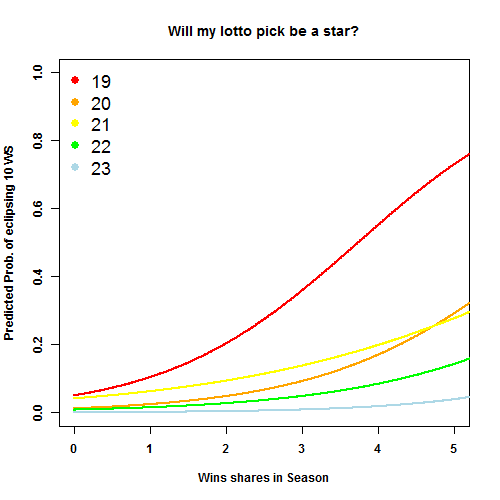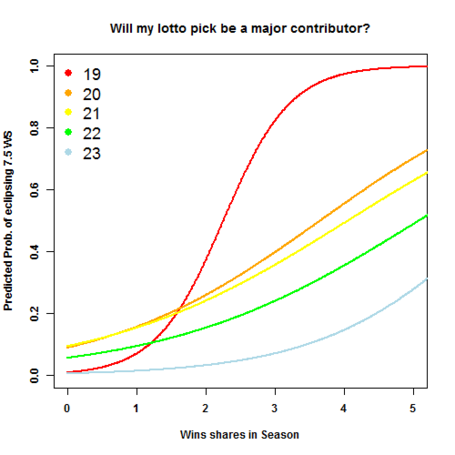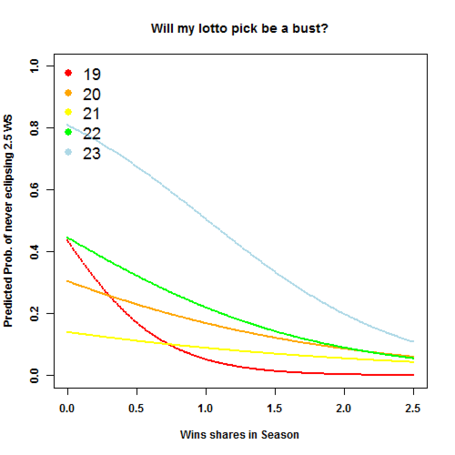Page 1 of 1
What early returns mean for lotto picks
Posted: Thu Jan 30, 2014 10:17 pm
by VJL
I did a little work looking at the likelihood of a player reaching certain career benchmarks based on production at a young age. I posted a more narrative version at Canis Hoopus (
http://www.canishoopus.com/2014/1/30/53 ... ly-returns), but I wanted to throw up some of the plots for discussion in the APBRmetric community.
Predicted probability plots for likelihood of becoming a....



Hopefully the plots are pretty self-explanatory, but let me know if anything isn't clear.
Re: What early returns mean for lotto picks
Posted: Fri Jan 31, 2014 2:09 pm
by nbacouchside
Great stuff VJL. Really interesting.
Re: What early returns mean for lotto picks
Posted: Sat Feb 01, 2014 5:11 am
by Bobbofitos
this is really well done
Re: What early returns mean for lotto picks
Posted: Sat Feb 01, 2014 1:42 pm
by mtamada
Interesting stuff. But wouldn't years in the NBA be a stronger predictor than age? Or even better, a measure of "equivalent years", which combines experience and age.
Although measuring the probability of reaching a certain win-shares level provides an easy-to-graph measure, it reduces information by reducing the measure of success to a yes-no measure. I think it'd be more informative to graph the win shares, rather than the probability of reaching a win-shares level. In particular, there would then be a range of outcomes, and the possibility of drawing graphs which show the range of outcomes (confidence intervals or 25th and 75th percentiles). E.g. maybe there's a 23 year old player who hasn't accomplished much yet, and has only a 5% chance of becoming a decent player. But if that player is among the 5% who were late bloomers, are we talking about a future Bill Laimbeer or a future Jayson Williams?
I'm thinking of Bob Cousy's adage that it takes three years before one can really gauge a player's quality. Obviously an instant superstar like a Jordan or Bird will be obvious right from the start, but players who are decent but not superstars often take longer to show their true value.
Yet another way to put it: I'm sure it is true that the majority of players with mediocre statistics at age 22 or 23 have only a small chance of becoming major contributors. But I wonder if the majority of NBA players fall into exactly that pattern: players who are stars from the start are rare. And so the bulk of NBA players, the ones in the fair-to-middling range, may have all started out with mediocre statistics. So despite the low probability of a young under-performer turning into a decent contributor, such players may be the main source of future decent contributors. The odds may be against them, but the players who do make it are the ones who beat the odds.
Re: What early returns mean for lotto picks
Posted: Mon Feb 03, 2014 5:31 am
by VJL
Re: Age vs. experience... I considered just looking at rookies, but opted for this approach since it gave a better sample size. I do think there is a significant difference between 1st and 2nd year beyond age, but wager most of the difference beyond that is just age. It would be interesting to try a combined metric that merges age and experience, but I am not sure how I would go about that.
Re: probabilistic dependent... I think what you note would basically just replicate the many age-curves out there. I wanted to look at it this way for several reasons. 1) Lottery picks are often viewed as gambling for a star. Picking a "star" is a central goal because the luxury of being able to use a max contract on a player worth much more than that is step 1 to winning a championship. Meanwhile good or even really good players ultimately end up getting paid appropriately which is only marginally beneficial in a capped league... especially if you blow two or three years of heavy minutes on them before they have developed into + players. I think this approach helps answer the question of when you should abandon a bad gamble for either an immediately useful player or another round in the lotto. 2) age curves are heavily influenced by the extreme cases and I think this approach helps see development with age from a different perspective.
Re: What early returns mean for lotto picks
Posted: Mon Feb 03, 2014 8:02 am
by Barncore
This is really interesting. But i don't know if WinShares are the best way to measure the quality of player, since a player's WS has a lot to do with the amount of playing time they get, which depends largely on the coach/system and team circumstance. I'd be interested to see how this would look with RAPM used instead. Or even WS/48.
Re: What early returns mean for lotto picks
Posted: Mon Feb 03, 2014 2:39 pm
by VJL
I generally prefer rate stats myself, but I like Win Shares in this case because it adds the additional evaluation measure of coach's opinion, makes it so that I don't need to find some minimum believable cut-off, and doesn't give a pass to players who can't get off the bench. It has some obvious short-comings like poor evaluating coaches and injuries... but if you follow the link (
http://www.canishoopus.com/2014/1/30/53 ... ly-returns) I have some lists of players at different benchmarks and these excuses rarely apply.
I have the data to look at this for RAPM pretty easily, so I might when I get some free time.
Re: What early returns mean for lotto picks
Posted: Wed Feb 05, 2014 4:35 pm
by Barncore
Hey VJL, i noticed you added RAPM
to your spreadsheet. Just curious, do you weigh age into the projection?
Re: What early returns mean for lotto picks
Posted: Thu Feb 06, 2014 12:25 am
by VJL
Barncore:
Yeah, age is in all of the models as is SOS and MOV (which surprisingly sometimes carries more information than SOS).
I added the RAPM model that is just looking at straight RAPM-O and D separately. You may notice that it really likes bigs. I think what is happening is that RAPM likes bigs a lot defensively, and the defensive model is quite a bit stronger than the offensive model. Shooting efficiency is an essential part of good offense and unfortunately is extremely noising between NCAA and NBA. I could probably improve on it with shot-location and other situation offense data, but that simply isn't publicly available going back more than a couple of years.
I also changed the dependent variable in my other models from Win Shares in peak season to a combination of Win Shares and "RAPM-wins" which is just a wins-added version of RAPM that gets at how much a guy added across the season. So RAPM is in everything now. Kind of surprisingly it didn't change the EWP model very much. The one interesting change is that Andre Drummond now pops up as the #2 pick in 2012 in the out-of-sample retrodictions. Kind of crazy given how boring his box-score production was at UCONN.
Re: What early returns mean for lotto picks
Posted: Thu Feb 06, 2014 3:18 am
by Barncore
Awesome. I was hoping you would merge the two.
Unrelated: I wonder when Mike Muscala will get a chance in the NBA.
Re: What early returns mean for lotto picks
Posted: Fri Feb 07, 2014 4:40 am
by sethypooh21
Late to this, but found this analysis really enjoyable.





